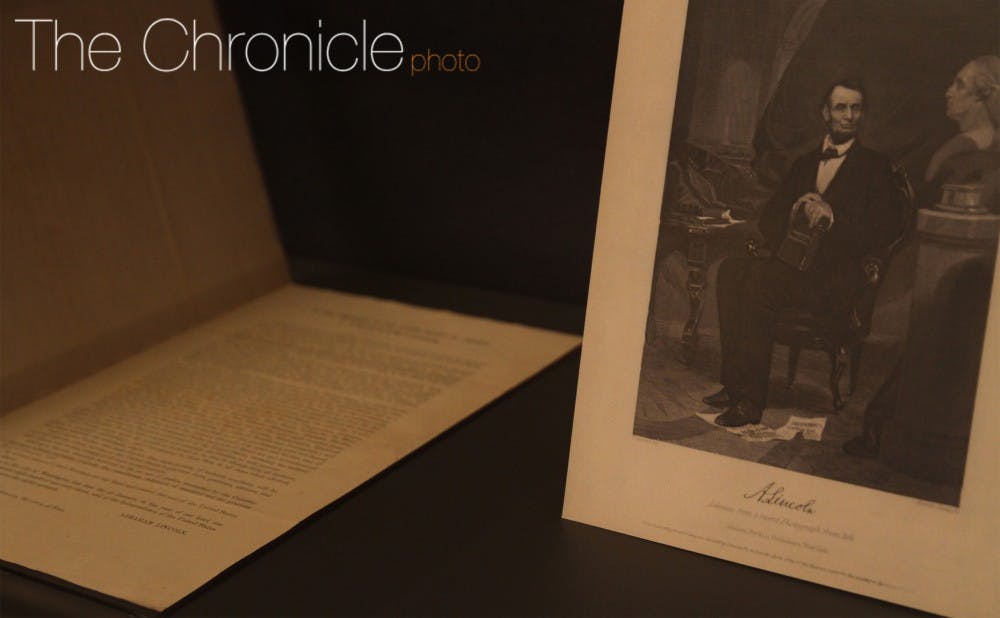A rare copy of the Emancipation Proclamation signed by President Abraham Lincoln recently made its way to Duke’s campus.
The document—one of nine produced in its fourth printing on Jan. 4, 1863, three days after the Emancipation Proclamation went into effect—emancipated slaves in states rebelling against the Union. It is on loan from David Rubenstein, Trinity ’70 and chair of the Board of Trustees, who purchased the item for his personal collection.
“We are very fortunate that Mr. Rubenstein decided to share this rare document with our community, we hope that as many people as possible will come and see it,” said John Gartrell, John Hope Franklin Research Center Curator at Duke University Libraries. “I think that this particular copy of the Proclamation, which was to be circulated to foreign ports, is important to understanding the global impact of emancipation in America and the reality of the crumbling institution of slavery around the world at that time.”
The document is on display next to another document Rubenstein has loaned to the library—the Bay Psalm Book—which was published in 1640 and is believed to be the first book published in America.
The Emancipation Proclamation will be on display in the Mary Duke Biddle Rare Book Room in the Rubenstein Library through at least April. In the recently-renovated Rubenstein library, the Mary Biddle Rare Book Room has been repurposed as a full-time exhibition suite, featuring the Josiah Charles Trent History of Medicine Room and Michael and Karen Stone Family Gallery. The room is open for visitors to see exhibits Monday through Friday from 9 a.m. until 5 p.m.
Naomi Nelson, director of the David M. Rubenstein Rare Book & Manuscript Library, gave The Chronicle a special look at what she thinks are 11 of the most interesting items housed in the Rubenstein Library that are currently on display for students. Nelson declined to comment on the estimated value of the items, writing in an email that the importance of the exhibits is marked by their research and educational value rather than their price.
Ashkar-Gilson MS02 (circa 600-800 C.E.)
One of the oldest items in the collection, the 1,300-year-old fragment of a Hebrew Torah scroll is one of very few texts to survive from the “silent period” between the second and ninth centuries C.E. It includes the oldest piece of literature in the Bible, the Song of the Sea, which appears in the Book of Exodus. The text was a gift from Fuad Ashkar and Albert Gilson in 1980.
Greek MS 65, 11th c. C.E.
A cycle of readings from the Gospels handwritten on parchment and bound in red goatskin with an ornate silver covering. It originally lay on the altar of an Orthodox church in Turkey and was a gift of the Friends of the Library in 1975.
Anne Bradstreet’s “The Tenth Muse Lately Sprung Up in America,” 1650
Anne Bradstreet was America’s first published poet. Her manuscript of poems was a gift from Lisa Unger Baskin, a noted collector of issues related to women’s history, in 2015. It is part of the Lisa Baskin Collection.
Phillis Wheatley’s “Poems on Various Subjects, Religious and Moral,” 1773
Phillis Wheatley—who had been enslaved as a child and was still enslaves when the book was published—was the first black American to publish a book. This copy is signed by Wheatley and once belonged to Charles Cotesworth Pinckney, who served as one of South Carolina’s delegates to the Constitutional Convention. It was purchased in 1935.
United States. “Articles of Confederation and Perpetual Union....”, 1777
This is one of very few surviving copies of the first printing of the first constitution of the United States. It was accessioned in 1938.
John James Audubon’s “The Birds of America; from original drawings,” 1827-38
This monumental four-volume, double-elephant-folio edition on handmade paper measures three feet tall and two feet wide. Audubon captured every bird native to America “in full size, in full color, and in natural settings.” It is one of only 125 surviving complete sets, and was purchased in 1930.
Walt Whitman’s “Leaves of Grass,” 1855
Three of the only 200 surviving bound copies of Whitman’s self-published book are in the Rubenstein Library. Whitman oversaw all aspects of the production of the book, which became a landmark of American literature.
Ivory Anatomical Manikins, 18th-19th centuries
The Trent Family donated these detailed ivory carvings with removable parts depicting the human body in 1956.
Virginia Woolf’s Writing Desk
Virginia Woolf was one of the leading figures of modernist literature. She ordered a standing desk when she was a teenager, around the time she decided that she would be a writer. The desk was purchased in 2015 and is part of the Lisa Baskin Collection.
Edward S. Curtis’ “The North American Indian,” 1907-1930
In this epic undertaking, Curtis sought to document Native American culture across North America through photography and ethnography. The resulting 20 volumes and 20 portfolios included 2,000 selected images—500 sets were published and fewer than 300 were sold. Curtis’s work was published in 1946.
“The Whole Booke of Psalmes,” 1640
Celebrated as America’s first book, it was the first English language book printed in America. This is one of only 11 surviving copies and on loan from Rubenstein.
Get The Chronicle straight to your inbox
Signup for our weekly newsletter. Cancel at any time.

